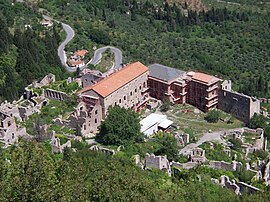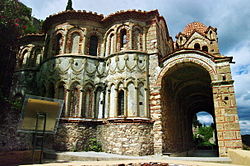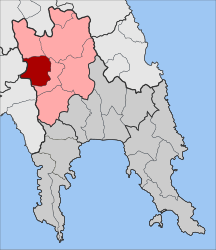Mistra
|
Mystras Μυστράς |
|
|---|---|

Mystras' Palace
|
|
| Coordinates: 37°4′N 22°23′E / 37.067°N 22.383°ECoordinates: 37°4′N 22°23′E / 37.067°N 22.383°E | |
| Country | Greece |
| Administrative region | Peloponnese |
| Regional unit | Laconia |
| Municipality | Sparti |
| • Municipal unit | 131.9 km2 (50.9 sq mi) |
| Elevation | 310 m (1,020 ft) |
| Population (2011) | |
| • Municipal unit | 4,265 |
| • Municipal unit density | 32/km2 (84/sq mi) |
| Community | |
| • Population | 832 (2011) |
| Time zone | EET (UTC+2) |
| • Summer (DST) | EEST (UTC+3) |
| Postal code | 231 00 |
| Area code(s) | 27310 |
| Vehicle registration | ΑΚ |
| Website | mystras.gr |
| Archaeological Site of Mystras | |
|---|---|
| Name as inscribed on the World Heritage List | |
 |
|
| Location | Greece |
| Type | Cultural |
| Criteria | ii, iii, iv |
| Reference | 511 |
| UNESCO region | Europe and North America |
| Inscription history | |
| Inscription | 1989 (13th Session) |
Mystras or Mistras (Greek: Μυστρᾶς/Μιστρᾶς), also known as Myzithras (Μυζηθρᾶς) in the Chronicle of the Morea, is a fortified town and a former municipality in Laconia, Peloponnese, Greece. Situated on Mt. Taygetos, near ancient Sparta, it served as the capital of the Byzantine Despotate of the Morea in the 14th and 15th centuries, experiencing a period of prosperity and cultural flowering. The site remained inhabited throughout the Ottoman period, when it was mistaken by Western travellers for ancient Sparta. In the 1830s, it was abandoned and the new town of Sparti was built, approximately eight kilometres to the east.
Since the 2011 local government reform it is part of the municipality Sparti, of which it is a municipal unit. The municipal unit has an area of 131.948 km2.
In late 1248, William II of Villehardouin, ruler of the Frankish Principality of Achaea, captured Monemvasia, the last remaining Byzantine outpost on the Morea. This success was soon followed by the submission of the restive Tsakones on Mount Parnon, the Slavic Melingoi tribe of Mount Taygetos, and the inhabitants of the Mani peninsula, thereby extending his sway over all of Laconia and completing the conquest of the peninsula, which had begun in 1205, in the aftermath of the Fourth Crusade. Laconia was incorporated into the princely domain, and the young prince passed the winter of 1248–49 there, touring the country and selecting sites for new fortifications such as Grand Magne and Leuktron; finally, near his residence of Lacedaemon (ancient Sparta), on a spur of Mount Taygetos, he built the fortress that came to be known as Mystras.
...
Wikipedia


